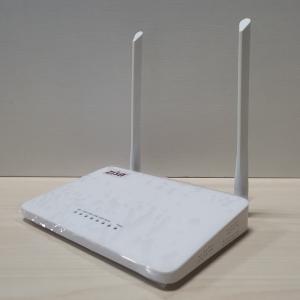Protocols
RFC 2684 Multiprotocol Encapsulation over ATM Adaptation Layer 5
RFC1483 Multiprotocol Encapsulation over ATM Adaptation Layer 5
RFC2516 PPP over Ethernet (PPPoE)
RFC1662 PPP in HDLC-like Framing
RFC1332 PPP Internet Protocol Control Protocol
RFC894 A Standard for the transmission of IP Datagrams over
Ethernet Networks
RFC1042 A Standard for the transmission of IP Datagrams over IEEE
802 Networks
MER (IP over Ethernet over AAL5)
PPTP, L2TP, IPSec, and SIP application layer gateway (ALG)
Self-learning bridge (IEEE 802.1D Transparent Bridging)
Support at least 64 learning MAC addresses
RFC768 User Datagram Protocol (UDP)
RFC791 Internet Protocol (IP)
RFC792 Internet Control Message Protocol (ICMP)
RFC793 Transmission Control Protocol (TCP)
RFC826 An Ethernet Address Resolution Protocol (ARP)
RFC862 Echo Protocol
G.992.1 (T1.413)
G.992.2 (G.dmt), G.lite
G.992.3 (G.bis/ADS L2)
G.992.5 (ADSL2+)
Annex L (reach extended ADSL2)
ATM forum UNI3.0, 3.1 and 4.0 permanent virtual circuits (PVCs)
CBR, UBR, VBR-rt and VBR-nrt
ITU-T i.610F4/F5 OAM
IP routing
Wireless Features
Standard
IEEE802.11b/g/n
Modulation schemes
802.11g: 64QAM, 16QAM, QPSK, BPSK,DSSS
802.11b: CCK, DQPSK, DBPSK
HT20 and HT40: 64 QAM, 16QAM, QPSK,BPSK
Modulation schemes
802.11g: 64QAM, 16QAM, QPSK, BPSK,DSSS
802.11b: CCK, DQPSK, DBPSK
HT20 and HT40: 64 QAM, 16QAM,QPSK, BPSK
Wireless data rate
802.11b: 11, 5.5, 2, 1 Mbps per channel,auto fallback for
extended range
802.11g: 54, 48, 36, 24, 18, 12, 9, 6 Mbps per channel, auto
fallback for extended range
HT20: up to 150 Mbps
HT40: up to 300 Mbps
Operating channels
802.11b:
– 4: France
– 11: USA and Canada
– 13: Most European countries
– 14: Japan
802.11g:
– 11: USA and Canada
– 13: Most European countries
– 14: Japan
HT20:
– 11: USA and Canada
– 13: Most European countries
– 14: Japan
HT40:
– 3—9: USA and Canada
– 3—9: Most European countries
Transmission distance
100m indoors coverage area
300m outdoors coverage area (varying depending on the actual
environment)
Security
64-bit, 128-bit WEP, AES, TKIP, WPA,WPA2, 802.1x
Basic Features
Set IP address and subnet mask at the LAN end and manage domain
Name
VLAN and port binding at the LAN end
Multi-IP address management at the LAN end
DHCP server, Option 60/15/42/50/250, and management of multiple
address pools
DHCP Relay, compatible with RFC2131, RFC951, RFC1542
10M/100M, self-adaptation, half duplex and full duplex management
of the LAN port
Up to eight WAN connections
Static uplink, configuring of static IP address, subnet mask,
DNS, and gateway
PPPoE uplink, configuring of user name, password, MRU, PAP and
CHAP authentication, disconnection upon idle overtime
DHCP uplink, obtaining the IP address through DHCP
Bridge uplink
VLAN at the WAN end and 802.1q VLAN
NAT and NAPT
Advanced Features
ALG: TFTP/FTP/PPTP/RTSP/L2TP/H323
MAC address filtering in the whitelist mode
Virtual server (NAPT configuration page), meeting the TR098
requirements for port mapping nodes, supporting 16 entries of
virtual server configuration
DNS agent
Manual configuration of DNS
QoS:
– Interface management, supporting strict-priority (SP) and DWRR
scheduling modes
– Queue management, supporting eight priority queues
– Flow classification management
Anti-DoS, independent switch for each protection item, and
anti-portscanning switch
IP filtering, security level configuration, blacklist and
whitelist based on WAN/LAN end (each list supporting up to 20
entries of IP filtering configuration)
Ping/Web/Telnet/SSH/FTP/TFTP local access control
Ping/Web/Telnet/SSH/FTP/TFTP remote access control
UPnP
IGMP Snooping and IGMP data control of the port
IGMP relay
Static routing management, supporting up to 16 entries of static
routing configuration
Dynamic routing management, RIPV1, RIPV2, active and passive
Modes
SNTP
URL filtering, blacklist and whitelist filtering, supporting up
to 20 URL entries
DMZ
Status Enquiry
System information
ADSL information
Host list at the LAN end
WAN connection status and statistics information
LAN statistics information
Configuration Management
Web, TR069 and SNMP configuration management
Telnet and SSH
Restore to the factory defaults and keep key parameters, reboot
the router
Two-level user management, including administrator and user
Ping diagnostics
Software version upgrade, double Image backup, and HTTP upgrade
Upgrade and download of the configuration file of HTTP and TFTP
server
Record log, upload log through TFTP, clear log, and download log
through HTTP
External Connectors
1 x RJ11 DSL interface
1 x WPS/WLAN button
1 x reset button
4 x RJ45 Ethernet interfaces
1 x USB host 2.0 interface
1 x power interface
1 x power switch
Ethernet Interface Features
Fully compliant with IEEE802.3/802.3u standards
10Base-T and 100Base-TX
Half duplex and full duplex
Auto MDI/MDIX
Flow control
Consumption
7W
|


